“This sudden plash into pure wildness – baptism in Nature’s warm heart – how utterly happy it made us!” John Muir wrote in The Story of My Boyhood and Youth, describing his arrival, in 1849 at the age of eleven, at Fountain Lake, where his father had purchased land for a homestead farm.
After fifteen hours of driving on interstate highways from northern Virginia, I was finally here, in rural south-central Wisconsin, about an hour and a half north of the state capital, Madison, and half an hour north of Portage. As you may have noticed, I’ve followed Muir’s “footsteps” to several places by now: to Cathedral Peak in the Sierra Nevada, which he climbed during his first summer in the Sierra; to the Petrified Forest in Arizona, where he explored fossil “forests” from the Triassic Period; and to the Andes of Chile where he went on his last major journey, at the age of 73, to see forests of Araucaria araucana, the monkey puzzle tree. But it was here in Wisconsin that Muir first encountered wild nature, and where that formative experience laid the foundation for the passion he pursued the rest of his life. I was curious to see what this fountain of “pure wildness” looked like today, and to imagine how John Muir saw it and how it influenced all of what he did later in his amazing life.
This was a pilgrimage. By visiting the Muir homestead at Fountain Lake, I was trying to find a personal, spiritual connection – which all pilgrims seek – with the landscape and place that first inspired Muir.
I drove into Montello, the county seat of Marquette County, and checked into the “Bayside Resort,” a small motel-like place on the south shore of algae-choked Lake Montello. It was quiet and nearly deserted on a summer Tuesday morning. After chatting with the owner and unpacking a bit, I drove south on County Road F to the John Muir Memorial County Park. At the boat launch a family of typically overweight midwesterners was wading and lounging on the dock, which was surrounded by a natural garden of white water lilies in bloom.
——-
Our only source for understanding Muir’s emotional reaction to the natural environment of his boyhood in frontier Wisconsin comes from his recollections in The Story of My Boyhood and Youth, written in 1912, more than 60 years after he arrived at Fountain Lake. He remembered, and wrote:
“To this charming hut, in the sunny woods, overlooking a flowery glacier meadow and a lake rimmed with water lilies, we were hauled by an ox-team across trackless Carex swamps and low rolling hills sparsely dotted with round-headed oaks.
This sudden plash into pure wildness–baptism in Nature’s warm heart–how utterly happy it made us! Nature streaming into us, wooingly teaching her wonderful glowing lessons, so unlike the dismal grammar ashes and cinders so long thrashed into us. Here without knowing it we still were at school; every wild lesson a love lesson, not whipped but charmed into us. Oh, that glorious Wisconsin wilderness! Everything new and pure in the very prime of the spring when Nature’s pulses were beating highest and mysteriously keeping time with our own! Young hearts, young leaves, flowers, animals, the winds and the streams and the sparkling lake, all wildly, gladly rejoicing together!”
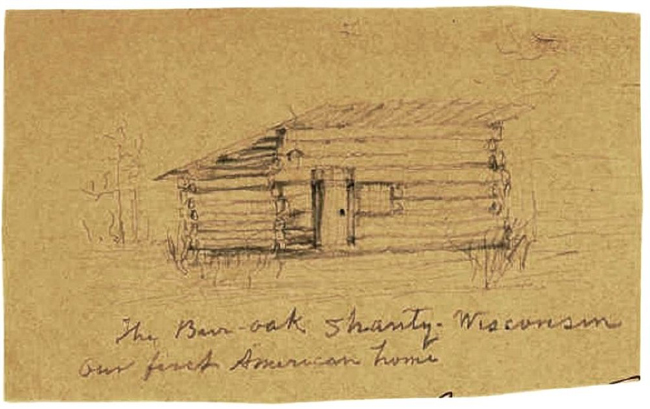
Muir’s sketch of the burr-oak shanty. Source: Marquette County John Muir Nature and History Route, Wisconsin Friends of John Muir.
“Everything about us was so novel and wonderful that we could hardly believe our senses except when hungry or while father was thrashing us. When we first saw Fountain Lake Meadow, on a sultry evening, sprinkled with millions of lightning-bugs throbbing with light, the effect was so strange and beautiful that it seemed far too marvelous to be real. Looking from our shanty on the hill, I thought that the whole wonderful fairy show must be in my eyes… But when I asked my brother if he saw anything strange in the meadow he said, “Yes, it’s all covered with shaky fire-sparks.”
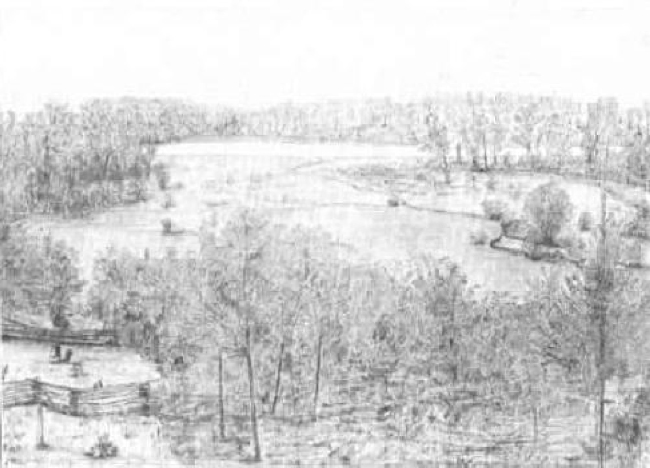
John Muir’s sketch of Fountain Lake from the house, reproduced in The Story of My Boyhood and Youth, 1913.
The “charming hut” where John and his father, brother, and sister first lived at Fountain Lake was quickly built with local materials by Muir’s father and neighbors, a “shanty” sided with slabs of burr oak and a floor of white oak. Over the summer his father supervised the construction of an eight-room house, which was completed by the autumn of 1849, when Muir’s mother and four other siblings arrived from Scotland.
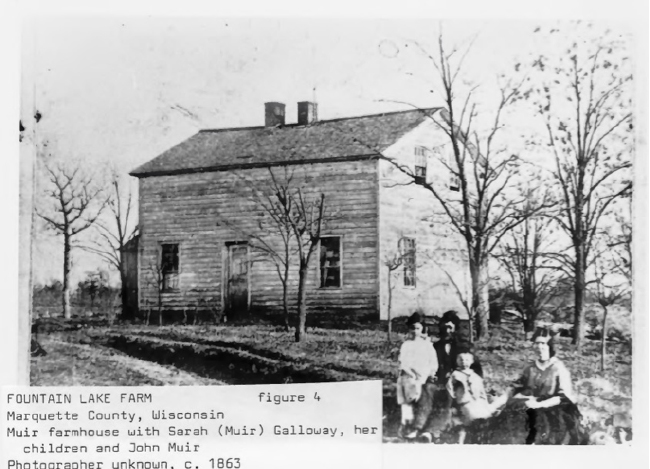
Source: Accompanying photos from Fountain Lake Farm National Historic Landmark Nomination. National Park Service. 1989.
The Story of My Boyhood and Youth is full of descriptions of birds, and the young “John o’ the Mountains” reveals himself a kindred spirit to his later friend John Burroughs, who was called, in contrast, “John o’ the Birds.” In Chapter Four Muir calls the Fountain Lake Farm “A Paradise of Birds,” and begins: “The Wisconsin oak openings were a summer paradise for song birds, and a fine place to get acquainted with them; for the trees stood wide apart, allowing one to see the happy home-seekers as they arrived in the spring, their mating, nest-building, the brooding and feeding of the young, and, after they were full-fledged and strong, to see all the families of the neighborhood gathering and getting ready to leave in the fall.”
Erik Brynildson, a Wisconsin architect who played a key role in the conservation of the Fountain Lake Farm, wrote about Muir that “As a boy, he would climb atop the roof of the bur-oak shanty and watch courting cranes dance as a river of passenger pigeons roared by overhead.” The painting below by Wisconsin artist Janet Flynn – courtesy of the Wisconsin Friends of John Muir, a local non-profit organization based in Montello with the mission to maintain Muir’s legacy in the area – depicts the birds Muir wrote about seeing at his childhood home. All but two species, the extinct passenger pigeon, and the locally extirpated prairie chicken, are still found around Fountain Lake.
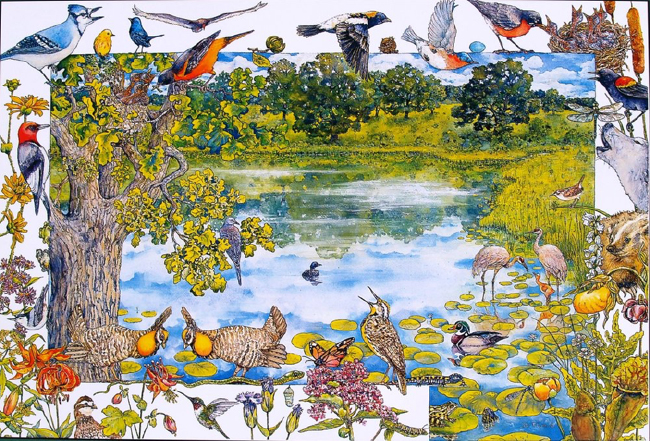
Birds of John Muir’s boyhood at Fountain Lake, painting by Janet Flynn. Source: Marquette County John Muir Nature and History Route, Wisconsin Friends of John Muir.
——-
As part of my pilgrimage, I wanted to understand the context into which the Muirs arrived at Fountain Lake – the “deep time” context, both ecologically and culturally. A very brief summary starts at the end of the Wisconsin Glacial Episode about 11,000 years ago, when the continental ice sheet began to melt and retreat, dumping its load of glacier-ground rocks, gravel, sand, and silt on the Wisconsin “sand counties.” Fountain Lake – since renamed Ennis Lake – was created when a huge stranded chunk of the ice sheet melted, leaving a depression in the glacial “drift.”
Muir wrote in The Story of My Boyhood and Youth that many Sunday afternoons were spent “on the highest rocky hill in the neighborhood, called the Observatory.” According to the Wisconsin Friends of John Muir, “Observatory Hill is an important historic and geologic landmark in Marquette County and was a favorite haunt of famed naturalist John Muir who grew up in Marquette County. For generations, early settlers picked ferns to adorn their churches and held picnics on the beautiful land at Observatory Hill. The hill is the highest point in the county, rising 300 feet above the surrounding land. It is 1500 feet above sea level.” Glacial scouring and striations in the rhyolite of Observatory Hill record the movement of the continental ice sheet that once moved across this landscape. Looking at Observatory Hill’s wimpy profile, I thought of Muir’s later love of the high Sierra of California, his recognition that they were glacial landscapes, and his later research on Alaskan glaciers, and I wondered: was there any connection between boyhood afternoons lolling on Observatory Hill – all of 300 feet high – and his later love of glaciers? Did he recognize those striations in the rocks on Observatory Hill, which he must have observed as a boy, as the footprints of a giant continental glacier?
——-
Okay, that’s a sketch of the geological context. What about the ecological?
Into the already warming and drying post-ice-age climate, nomadic hunters arrived from Asia after crossing the Bering land bridge, bringing with them to the American continent a tradition of hunting with fire. By setting fire to the landscape to encourage the expansion of the prairies and savannas on which the large game they hunted could thrive, they reshaped North American ecosystems, which unlike the ecosystems of Africa and Eurasia had not experienced such a level of burning before. The result, in this part of Wisconsin, were the “oak openings,” an anthropogenic landscape resulting from indigenous game management based on fire. Regular fires favored some species and eliminated others, shaping the vegetation into prairie and oak savanna. “At one time, oak savanna was the most common plant community in southern Wisconsin. It covered 5.5 million acres, or 75%, of southern Wisconsin,” according to an informational sign at a rest stop on Interstate 39 south of Portage, where the Wisconsin Department of Transportation has a project to restore native prairie.
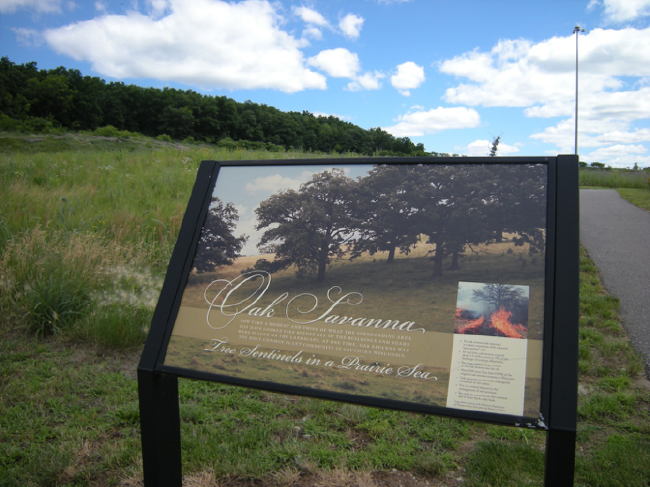
Informational sign about oak savanna and prairie restoration at rest area on Interstate 39 south of Portage
The Muir family arrived with the wave of European settlers only a few decades after the land was taken from its Native American inhabitants, and within a generation their agriculture and technology again reshaped the ecological landscape. They ploughed the tough prairie sod that held and recycled soil nutrients, and they suppressed fires. Trees crept in wherever they could, and the oak openings closed. Muir noted this loss, within a generation, of the sunny oak woods of his youth. With them went the habitat that favored the nesting songbirds that had delighted him so. According to the sign at the prairie restoration rest area, “Oak savannas are the most endangered ecosystem in the nation.”
Now, along the section of Wisconsin’s Ice Age Trail that circles Fountain/Ennis Lake, controlled burns are being used to restore prairie and oaks. As I walked the trail, the prairie was abloom with species such as black-eyed Susan, Rudbeckia hirta, which thrive with regular fire. Burr, white, and black oaks are fire tolerant, resprouting from their roots following fires, and little oaks were popping up here and there along the trail.
The soils of the Fountain Lake Farm were new and nutrient-poor, only recently ploughed up by the ice sheet from the bedrock, and were not great for farming. Brynildson wrote that “In seven years at the Fountain Lake Farm, the Muir’s wheat crops had basically worn out the soil, and Muir’s father moved the family east to clear a new farm, called Hickory Hill, closer to the town of Kingston. Ecologically, Daniel Muir could not have selected a richer place for son John’s nursery and perhaps a poorer place for a farm.”
Muir lived with his family at Hickory Hill from 1856 to 1861, when he enrolled in the University of Wisconsin in Madison. He studied there for two-and-a-half years; his main academic interests were geology and botany. In 1863 he returned to Hickory Hill, thinking that he might be drafted to fight in the Civil War, and in 1864 he went to Canada for two years, and never returned to live again in Wisconsin.
——–
“The roots of Muir’s love of nature and desire to preserve land for its esthetic value travel deep in the fens and oak savannas of Marquette County and the Park environs,” says the John Muir Park Ice Age Trail Guide. In 1864, before leaving for Canada, Muir attempted to buy a part of the Fountain Lake Farm from his brother Daniel and his sister’s husband. He wanted to preserve it in its wild state because of its emotional and aesthetic value to him, but his relatives refused to sell. Nevertheless, Aldo Leopold, the influential conservationist and writer whose Wisconsin “sand counties” farm was less than thirty miles west of the Muir farm, recognized and wrote about Muir’s pioneering attempt to preserve a piece of wild nature for its non-material values, anticipating his later role in preserving Yosemite in California. In the essay “Good Oak” in his classic A Sand County Almanac, Leopold wrote: “The saw now severs 1865, the pith year of our oak. In that year, John Muir offered to buy from his brother-in-law, who then owned the home farm 30 miles east of my oak, a sanctuary for the wildflowers that had gladdened his youth. His brother-in-law declined to part with the land, but he could not suppress the idea: 1865 still stands in Wisconsin history as the birthyear of mercy for things natural, wild, and free.” According to Byrnildsen (1988): “A year before A Sand County Almanac was published, Leopold wrote a letter to Wisconsin Conservation Department… proposing that the old Muir farm on Fountain Lake be designated as Wisconsin’s first state natural area. One week after the letter was written, Leopold died, on John Muir’s birthday, April 21, in 1948.”
Thirty-four years later, in 1972, Fountain Lake Farm finally became a state natural area, and it was designated a National Historic Landmark in 1990. Now a section of the Wisconsin “Ice Age Trail” circles the lake, and the Wisconsin Friends of John Muir have developed interpretive guides to help visitors and pilgrims like me navigate Muir’s boyhood “neighborhood,” including an information-rich interactive website, the “Marquette County John Muir Nature and History Route.”
——-
But now another, more philosophical, reflection from my pilgrimage to Fountain Lake. In The Story of My Boyhood and Youth Muir wrote: “Even if I should never see it again, the beauty of its lilies and orchids is so pressed into my mind I shall always enjoy looking back at them in imagination even across seas and continents and perhaps after I am dead.” This comment on how Fountain Lake would always live in his memory, and an allusion to “heaven,” was written near the end of his life. To me, it clearly reveals a teenage boy’s rebellion against his father’s hellfire-and-damnation religion, and Muir’s early abandonment of that bleak worldview in favor of a conviction that “god is nature, nature is god.”
“The old Scotch fashion of whipping for every act of disobedience or of simple, playful forgetfulness was still kept up in the wilderness, and of course many of those whippings fell upon me,” Muir wrote in The Story of My Boyhood and Youth. Not far from the Fountain Lake Farm is a small historic church called the “Wee White Kirk,” built by local Scottish immigrants, where Muir’s father Daniel was often invited to preach to the local congregation. I stopped on a hot, sunny afternoon, and walked around the church and the graveyard, where a number of Muir’s family friends and relatives are buried. The white starkness said all.
Muir’s psychological, emotional, and spiritual escape from his father’s harsh, hellfire religion was into what he called “Nature’s warm heart.” For John Muir, I think, the images from his early encounter with the glorious sunny wildness of the Wisconsin frontier at Fountain Lake were held and carried in his imagination through his whole life. Nature’s warm heart was god and heaven, beside and inside him even on unforgiving peaks in the Sierra Nevada, in stark graveyards of fossil forests in Arizona, or on the heartless, sublime glaciers of Alaska. I’m sure that when he died on Christmas Eve of 1914, alone in a hospital in Los Angeles, he passed into a blissful dream of white water lilies and fireflies and all the birds of Nature’s warm heart.
For related stories see:
- At Church with John Muir
- Following John Muir’s Footsteps in the Petrified Forest
- Picknicking in Deep Time
- Tracking John Muir to the Monkey Puzzle Forests of Chile
- Travels in Alaska: Seeking the Sublime Among Glaciers and Fjords
- An Afternoon at Slabsides with John o’ the Birds
- Another Visit with John Burrroughs at Slabsides
Sources and related links:
- Chronology (Timeline) of the Life and Legacy of John Muir
- John Muir. 1913. The Story of My Boyhood and Youth. Houghton Mifflin Company.
- Fountain Lake Farm: John Muir’s Boyhood Home
- Restoring the Fountain of John Muir’s Youth. Erik R. Brynildson. 1988.
- Fountain Lake Farm, Wisconsin Farm Home of John Muir. National Historic Landmark Nomination. Donald L. Stevens, Jr. 1989.
- Accompanying photos from Fountain Lake Farm National Historic Landmark Nomination. National Park Service. 1989.
- Fire in America: A Cultural History of Wildland and Rural Fire. Stephen J. Pyne. 1997. University of Washington Press.
- John Muir Park Ice Age Trail Guide
- John Muir Neighborhood Booklet
- Marquette County John Muir Nature and History Route
- “Good Oak,” essay from A Sand County Almanac. Aldo Leopold. 1949.

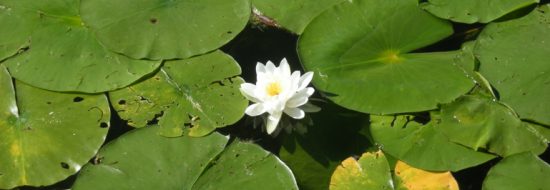
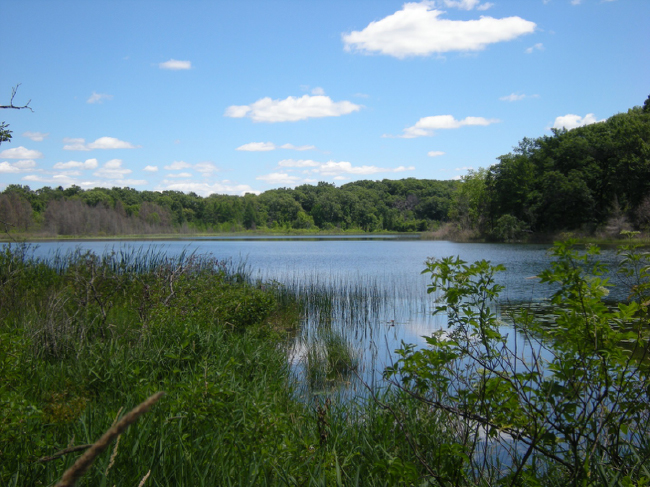
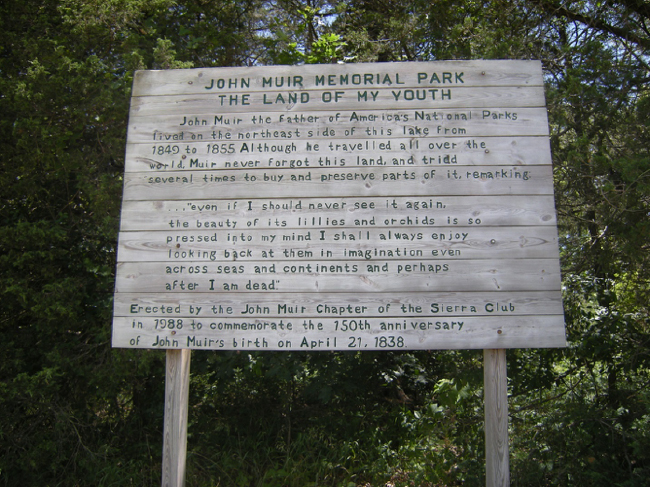
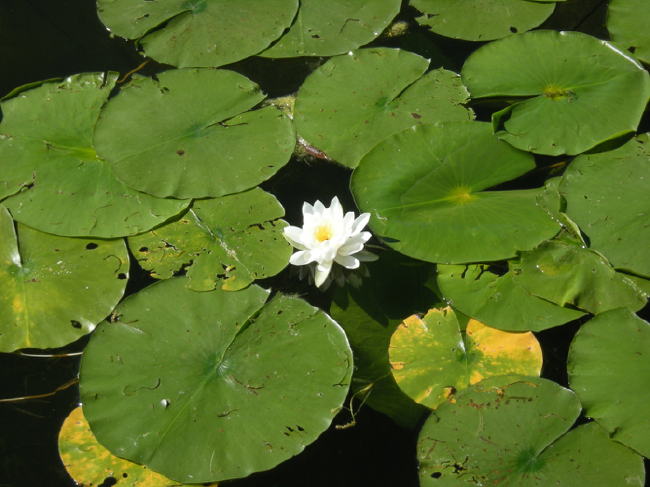
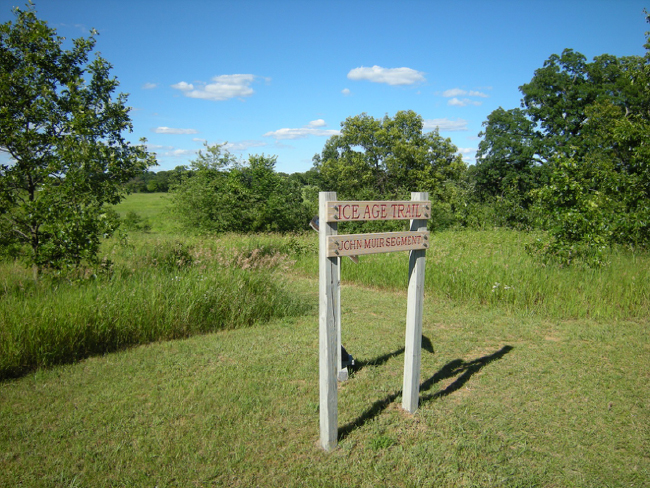
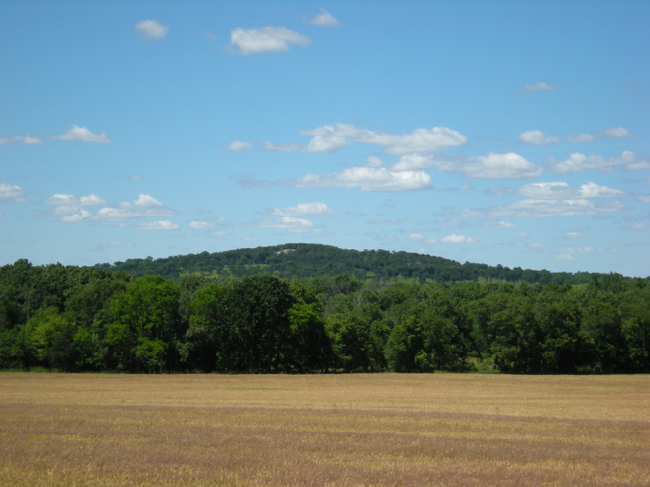

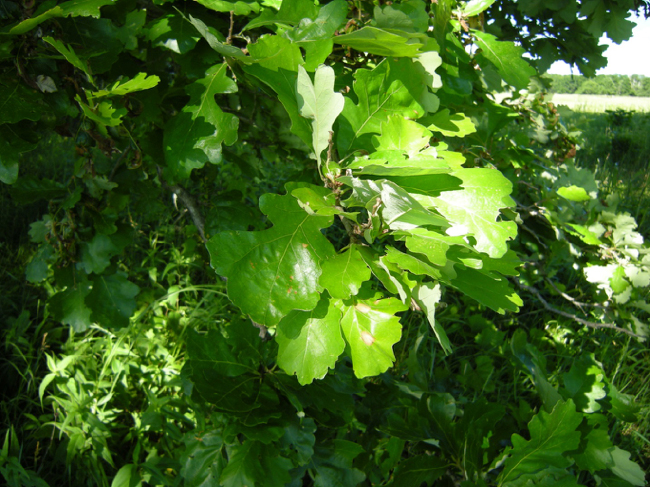
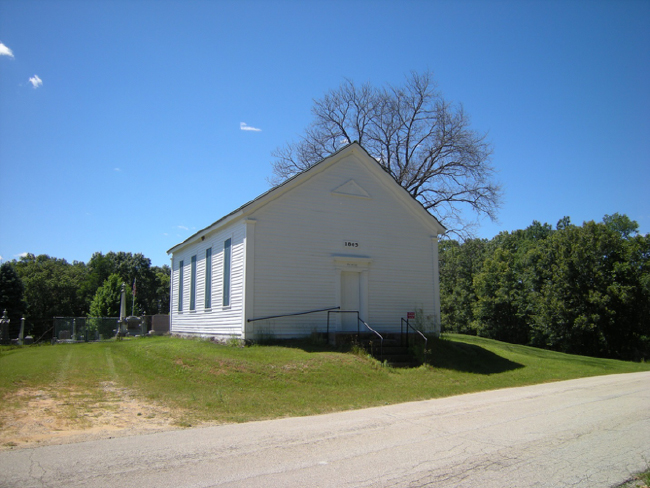



August 17, 2016 3:05 pm
Thanks for the odyssey!
I was in Muir woods last week in California and one can only imagine Muir’s initial thoughts upon contemplating those sequoias…
August 25, 2016 11:03 am
I’m glad you enjoyed your visit to Marquette County John Muir Park. The lovely place you stayed is the Bayview, not the Bayside. Montello Lake has an active Lake District that works hard to keep this impound lake accessible and a good fishing lake. It is not algae choked, rather, like most impound lakes in Wisconsin, it has invasive Eurasian milfoil that is hard to manage during certain times of the year like August. Some “typical overweight Midwesterners” are ones who volunteer hours and hours to preserve Muir’s legacy in his boyhood home. This county park was started with donated land from farm families and dedicated in 1957. More land was added with the Sierra Club raising money to purchase the large prairie north of the lake at one point of the development of the park. Today, Marquette County, the Marquette County Chapter of the Ice Age Trail, and the Wisconsin DNR along with many volunteers keep the park welcoming to visitors. The Wisconsin Friends of John Muir work to keep Muir’s legacy alive and host many educational opportunities like five children’s saunters this summer. Marquette County and Wisconsin Friends of John Muir along with other local groups who donate money and volunteer created the Marquette County John Muir Nature and History Route mobile app, the John Muir Neighborhood booklet, and a family guide for the park you can download from the app. It takes many local volunteer hours and the support of our local Marquette County government to keep John Muir Park open and a gift to those who visit. Come back again and enjoy other beautiful outdoor sites in Marquette County.